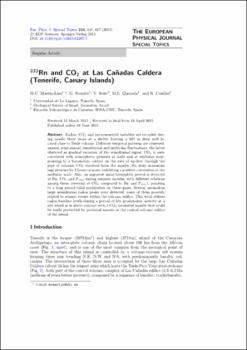222Rn and CO2 at Las Cañadas Caldera (Tenerife, Canary Islands)
Date
2015Abstract
Radon, CO2 and environmental variables are recorded during nearly three years at a shelter hosting a 505 m deep well located close to Teide volcano. Different temporal patterns are observed, annual, semi-annual, semidiurnal and multi-day fluctuations, the latter observed as gradual variation of the semidiurnal signal. CO2 is anti-correlated with atmospheric pressure at daily and at multiday scale, pointing to a barometric control on the rate of up-flow through the pipe of volcanic CO2 exsolved from the aquifer. Rn daily maximum lags pressure by 2 hours or more, exhibiting a positive correlation at the multiday scale. Also, an apparent quasi-fortnightly period is detected at Rn, CO2 and Patm during summer months, with different relations among them (reversal at CO2 compared to Rn and Patm), pointing to a long period tidal modulation on these gases. Several anomalous large semidiurnal radon peaks were detected, some of them possibly related to seismic events within the volcanic edifice. This work defines radon baseline levels during a period of low geodynamic activity at a site which is in direct contact with a CO2 saturated aquifer that could be easily perturbed by potential unrests at the central volcanic edifice of the island.






